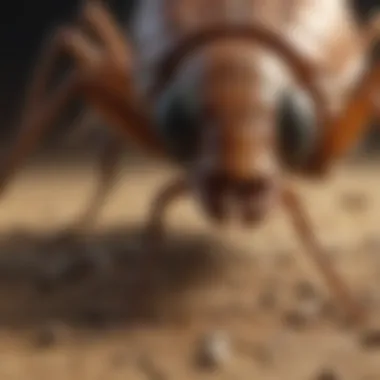Expert Insights on Pesticides for Termite Control


Intro
Termites are often unseen culprits that can cause significant damage to homes and gardens. Understanding the nature of these pests is crucial for effective control. By identifying termite species and their behaviors, homeowners can implement targeted strategies to prevent infestations.
Understanding Pests
Definition of Pests
In the context of pest control, pests are organisms that harm crops, structures, or health. Among the various pests, termites are particularly notorious. They feed on cellulose found in wood, paper, and other plant materials, leading to potentially devastating damage. Understanding the specific type of termite present in a home is essential for selecting the right method of control.
Importance of Pest Identification
Identifying the pest accurately is crucial to implement the correct management strategies. Termites can be broadly categorized into three groups: Subterranean, Drywood, and Dampwood. Each group has different habitats, feeding habits, and therefore, requires different approaches for control. Knowing which type of termite infests your space will guide homeowners in choosing appropriate pesticides.
"Effective pest control begins with proper identification. Understanding termites can save property from significant damage."
Prevention Techniques
Home and Garden Preventative Measures
Homeowners can take several steps to prevent termite infestations. First, eliminate wood-to-soil contact by keeping firewood, wooden structures, and debris away from the foundation. Sealing cracks in the foundation can also deter termites. Additionally, proper drainage in gardens will reduce moisture and limit the conditions that attract termites.
Seasonal Prevention Tips
Termite activity can vary seasonally. During the warmer months, inspect areas prone to moisture accumulation established by roof leaks or leaky pipes. Regular inspections during the spring and summer can assist in early detection. Utilizing barriers that repel termites is also an effective practice to consider as a precaution.
Eco-Friendly Pest Control Solutions
Overview of Sustainable Practices
Sustainable pest management is gaining attention. This approach integrates different strategies to minimize chemical use while addressing pest problems effectively. Homeowners can utilize physical barriers, biological controls, and cultural practices that enhance the environment rather than harm it.
Natural Remedies and Their Effectiveness
There are several natural remedies for termite control. For instance, borate solutions can disrupt termite digestion when ingested. Additionally, nematodes are microscopic worms that can kill termites in the soil. While these methods may require more time and effort, they present safe alternatives to conventional pesticides.
Understanding Termites
Understanding termites is crucial for effective pest management. These insects cause severe damage to homes and structures each year. Knowledge about their biology and behavior is foundational for identifying threats and applying appropriate control measures. This section will detail how termites operate and the types that homeowners may encounter. The insights gained here will inform your decisions on pest control, whether you handle the issue yourself or consult a professional.
Biology and Behavior of Termites
Termites belong to the order Blattodea, which also includes cockroaches. They are social insects that live in colonies, often ranging from a few thousand to millions. Their colonies consist of different castes: workers, soldiers, and reproductive individuals. Each caste has a specific role that supports the colony's survival.
- Workers: They are responsible for building and maintaining the nest, foraging for food, and caring for the young. Workers are sterile, wingless, and primarily focus on feeding the colony.
- Soldiers: Their primary role is defense. With larger mandibles, they protect the colony from predators. Soldiers cannot feed themselves and depend on workers for sustenance.
- Reproductive individuals: This group includes the queen and king. They are responsible for reproduction, ensuring the colony continues to thrive.
Termites mainly thrive in warm, humid environments. Their diet mainly consists of cellulose, which they obtain from wood, paper, and other plant materials. They possess symbiotic microorganisms in their guts that help them digest cellulose efficiently. This unique adaptation allows termites to break down materials that many other organisms cannot.
Types of Termites
Termites are categorized primarily into three groups based on their habitats:
- Subterranean termites: These are the most common type, known for their destructive nature. They build their nests underground and create mud tubes to travel to food sources. This type includes species like the Eastern subterranean termite, which is found across many regions.
- Drywood termites: Unlike subterranean species, drywood termites live in the wood they consume and do not need contact with soil. They can cause significant damage to wooden structures in a short time. This group is often found in warmer climates.
- Dampwood termites: These termites prefer decaying wood that is very moist. They are typically found in areas with high humidity, like coastal regions or areas with standing water.
Understanding the specific type of termite that infests a home is critical. Each type requires different treatment approaches. Knowing their biology and behaviors can lead to more effective pest management strategies.
In summary, comprehending the biology and types of termites lays the groundwork for addressing termite infestations effectively. It helps to identify the specific characteristics of each species, influencing treatment measures and effectiveness.
Overview of Termite Infestations
Understanding termite infestations is crucial for effective pest management. Termites can cause significant structural damage if left unchecked. The economic impact on homeowners can be considerable, not only due to repairs but also the potential decrease in property value. Recognizing infestation early is one of the best ways to mitigate these risks. This section will explore how to identify termite damage and the signs of termite activity.
Identifying Termite Damage
Identifying termite damage requires a keen eye. Common signs include wood that appears hollowed out. This occurs because termites consume the wood from the inside, leaving only a thin veneer. When inspecting wooden structures, tap on wood surfaces. A hollow sound often indicates infestation.
Another important aspect is noticing mud tubes. These are constructed by termites to create tunnels from the ground to their food sources. They are about the diameter of a pencil and can often be found along walls or foundations. Additionally, look for discarded wings. Termites swarm when they establish new colonies, leaving behind their wings as evidence.
Regular inspections, especially in the spring and summer, can help catch infestations early. Homeowners should maintain vigilance in areas known to harbor termites, such as basements and crawl spaces.
Signs of Termite Activity


Various signs can indicate active termite presence. First, pay attention to swarming. Termites leave their colonies to mate and form new colonies. This often occurs during warmer months, and you may find them indoors or around the foundation of your home.
Another indicator is the presence of fecal pellets. Termite droppings resemble small grains of sand or sawdust and can be found near entry points. These pellets indicate that the termites are actively feeding in the area.
Unexplained noises from walls, particularly at night, can also suggest termites at work. Homeowners should be aware of other unusual signs, such as cracked or distorted paint on walls. This can signal that termites are working behind the scenes.
The sooner you identify termite activity, the better your chances of preventing severe damage. Regular checks can save homeowners considerable time and money.
The Importance of Pest Control
The significance of effective pest control cannot be overstated. Particularly for termites, proper management strategies play a crucial role in safeguarding not just the integrity of structures but also the overall economy of the household. The nuances of termite behavior necessitate an informed approach to prevention, allowing homeowners to mitigate potential infestations before they escalate into significant damage.
Preventing Structural Damage
Termites are often referred to as silent destroyers. They can compromise the structural integrity of buildings without immediate signs of their presence. An infestation can lead to severe consequences, including costly repairs and loss of property value. By implementing proactive termite control measures, homeowners can effectively prevent structural damage.
Regular inspections and the use of appropriate pesticides can protect wooden structures, beams, and other cellulose-based materials that serve as a primary food source for termites. Understanding their habits can lead to targeted treatments and preventive strategies, making it easier to keep these pests at bay.
Some practical tips include:
- Routine Inspections: Conducting regular checks for signs of termite activity, such as mud tubes or discarded wings.
- Moisture Control: Reducing damp areas around the home limits the attraction for termites.
- Proper Ventilation: Ensuring adequate airflow in basements and crawl spaces also helps in preventing infestations.
By taking a preventive stance, homeowners can protect their homes and avoid the ordeal of extensive repairs that may arise due to significant termite damage.
Protecting Property Investment
Homeownership often represents one of the most substantial investments an individual can make. Therefore, protecting this investment is paramount. Termite control is an essential aspect of home maintenance that ensures the long-term value of a property. A home afflicted by termites not only faces immediate damage but also decreases in market value.
Investing in pest control can prove to be a cost-effective approach in the long run. Utilizing pest control methods—including the application of chemical and biological pesticides—can greatly decrease the risk of infestations. Just a few preventative steps can safeguard the value of one’s property.
Consider these points for protecting your property:
- Invest in Pest Control Services: Hiring professionals ensures thorough inspections and timely interventions.
- Regular Maintenance: Keeping up with home repairs and maintenance helps deter termite activity.
- Educate Yourself: Awareness of your surroundings can make it easier to spot irregularities that may signal termite presence.
Pesticide Options for Termite Control
The choice of pesticide options for termite control is essential in managing and preventing infestations. Homeowners and pest control professionals must make informed decisions about which pesticides will best address the specific needs of their properties. Understanding the various types of pesticides available, as well as their respective benefits and considerations, helps ensure effective treatment while maintaining safety and environmental integrity.
Chemical Pesticides
Chemical pesticides have traditionally been the first line of defense against termites. Their effectiveness in killing pests quickly is a primary reason for their prevalence.
Types of Chemical Pesticides
There are several types of chemical pesticides used for termite control, each with its unique formulation. These include organophosphates, pyrethroids, and neonicotinoids. Organophosphates, for instance, work by disrupting the insect’s nervous system, leading to rapid death. Pyrethroids mimic natural insecticidal compounds from chrysanthemum flowers and are widely used due to their effectiveness and relatively quick action.
The key characteristic of chemical pesticides is their ability to provide immediate results. This quick action makes them a popular choice among homeowners seeking fast solutions to infestations. However, the potential for adverse effects on non-target organisms and the environment is a considerable disadvantage that comes with their use.
Active Ingredients
Active ingredients in chemical pesticides determine their effectiveness, mode of action, and safety profile. Common active ingredients include fipronil, imidacloprid, and permethrin. Fipronil, for example, targets the nervous system of insects, making it particularly potent against termites.
These active ingredients are often favored for their established track records in pest control. They typically offer a high degree of effectiveness against various termite species. However, one must consider how these ingredients can impact beneficial insects, aquatic life, and overall ecosystem health. The potential for pesticide resistance in termite populations is another crucial factor to consider.
Effectiveness and Residual Activity
Effectiveness and residual activity are vital when evaluating chemical pesticides. Some chemical treatments can provide lasting protection, which is paramount in preventing future infestations. Products like fipronil offer residual activity that can last for years when applied correctly.
The key advantage of long-lasting residual formulations is reduced frequency of application, translating to less frequent investments for homeowners. However, it is important to balance this benefit with the potential for soil and water contamination if not used according to guidelines. Understanding this balance is necessary to make educated choices regarding termite control.
Biological Pesticides
Biological pesticides present an alternative to traditional chemical solutions. They utilize naturally occurring organisms or substances to control pest populations.
Overview of Biological Control
The use of biological control involves implementing organisms that can naturally suppress termite populations. This strategy includes introducing predators or pathogens like nematodes and fungi. The crucial aspect of biological control is its reliance on ecological processes instead of synthetic chemicals.
This method often appeals to environmentally conscious homeowners, as biological pesticides tend to have lower toxicity to non-target species and minimal environmental impact. On the downside, the effectiveness of these agents may vary based on environmental conditions and may take longer to achieve desired results.
Common Biological Agents
Common biological agents used in termite control include Beauveria bassiana, a fungus that infects termites, and entomopathogenic nematodes, which invade termite bodies. These agents can be effective but require specific application conditions to achieve success.


The advantage of using biological agents is their sustainability. Unlike traditional pesticides, they do not leave harmful residues in the environment, making them a favorable option for sensitive areas. However, their limitations include potential variations in efficacy based on external factors such as humidity and temperature.
Sustainability Considerations
Sustainability is a critical factor in modern pest management. Biological pesticides often provide a sustainable approach to pest control, contributing to long-term ecological health. Using these methods can reduce the need for harsh chemicals, thus promoting a healthier living environment for both humans and wildlife.
However, it is essential to consider that while biological methods are sustainable, they may require integrated approaches with chemical options to ensure complete control over severe infestations. This hybrid strategy allows for effective pest management without compromising ecological integrity.
Application Methods for Termite Pesticides
Effective termite control is not just about selecting the right pesticide; it is also about the methods used for application. The choice of an application method can significantly influence the efficacy of the treatment. Factors such as the level of infestation, the type of pesticide used, and the structure of the property will dictate the best approach. Understanding these methods is crucial for both homeowners seeking to protect their investment and pest control professionals tasked with managing infestations.
Soil Treatments
Soil treatments have long been a cornerstone of termite control. This method involves applying pesticides directly to the soil around a structure to create a barrier against termite invasion. One of the primary benefits of soil treatments is their long-lasting protection. When applied correctly, these treatments can last several years, minimizing the risk of future infestations.
The process typically involves trenching and injecting the pesticide into the soil. Professional pest control services often utilize specialized equipment for precision. However, it is important to consider factors like soil type and moisture, which can impact the effectiveness of the treatment. For example, sandy soils may allow for quicker degradation of chemical compounds, necessitating more frequent applications.
Additionally, the chemical formulation of the pesticide also plays a critical role. Liquid termiticides are often favored for their ability to create a continuous barrier. Alternatively, granular products may be used but require water activation to release the active ingredients effectively.
Baiting Systems
Baiting systems represent a more targeted approach to termite management. Instead of repelling or killing termites through barriers, these systems involve strategically placing bait stations around the property. Each station contains food that is laced with slow-acting insecticides. The termite workers consume the bait and share it with their colony, which helps in reducing the overall population.
This method has several advantages. One, it is less invasive, as there is no need for trenching or drilling. Two, it allows for ongoing monitoring of termite activity. Many bait systems come with indicators that show when termites are present, providing valuable information for homeowners and pest control professionals alike.
However, effective use of baiting systems requires a thorough understanding of termite behavior. Placing bait in the right locations, where termites are likely to forage, is critical for success. This generally involves research on the specific species of termite and their feeding habits.
Direct Injection Techniques
Direct injection techniques offer a concentrated approach to treating localized infestations. This method involves injecting pesticides directly into wood or infested areas of the structure. It is particularly useful for homes already experiencing termite activity in specific locations, such as mud tubes or damaged wood.
The direct injection method provides several benefits. For one, it allows for immediate action where needed without treating unnecessary areas. It is also less disruptive to the home environment compared to other application methods.
However, precision is essential. Improper application may lead to ineffective treatment or, worse, harm non-target organisms. It is generally advised to consult with a professional pest control operator for such localized treatments to ensure correct application and safety.
"Selecting the proper application method can significantly impact the effectiveness of termite control measures."
In summary, choosing the right application method for termite pesticides is crucial for effective pest management. Soil treatments establish protective barriers, baiting systems target infestations without invasive actions, and direct injection techniques address specific issues efficiently. Homeowners and pest control professionals must weigh the pros and cons of each method to determine what aligns best with their unique situations.
Safety and Environmental Considerations
The role of safety and environmental considerations in pesticide use for termite control cannot be overstated. It is essential to ensure that the methods chosen do not adversely affect human health, pets, or the surrounding ecosystem. Pesticides can be effective tools but come with potential risks. Therefore, a comprehensive understanding of their safe application and environmental impact is required.
Understanding Pesticide Safety
Pesticide safety involves awareness of both the application methods and the substances being employed. Homeowners and professionals should adhere to the instructions provided by manufacturers. This promotes effective pest control while minimizing unsafe exposure. The safety measures often include wearing proper protective gear such as gloves and masks during application. Furthermore, proper storage of pesticides is crucial, as is the disposal of any remaining substances after use. Ignoring these practices can lead to unintentional exposure and potential health risks, including skin irritations and respiratory issues.
Impact on Non-target Organisms
When applying pesticides, the potential effect on non-target organisms must be a priority. Non-target organisms include beneficial insects, birds, and other wildlife that contribute to a balanced ecosystem. Some pesticides can be highly toxic to these organisms, leading to reduced biodiversity. This may also indirectly affect human activities, such as gardening or farming. To mitigate these risks, it is advised to select products that target termites specifically, minimizing harm to non-target organisms. Integrated Pest Management (IPM) strategies can also be beneficial in balancing termite control and environmental preservation.
Regulatory Standards and Compliance
Regulatory standards and compliance are vital components of safe pesticide use. Various governments have established guidelines that determine which pesticides can be used, how they should be applied, and required safety measures. Adhering to these regulations helps protect both people and the environment. Additionally, these standards ensure that the chemicals used are shown to be effective and have undergone sufficient testing for safety. Homeowners should check for certification labels and ensure that their pest control practices are in compliance with local laws. Not only does this foster a culture of safety, but it also promotes responsible pest management practices in the community.
Integrated Pest Management Strategies
Integrated Pest Management (IPM) is a comprehensive approach that combines various control techniques to effectively manage pest populations while minimizing risks to human health and the environment. This strategy is particularly relevant in termite control as it ensures a balanced approach that can lead to long-term management of infestations.
Using IPM strategies means leveraging the strengths of different control methods. By combining both chemical and non-chemical practices, homeowners and professionals can achieve better results. IPM emphasizes the understanding of termite biology, behavior, and environmental factors. This knowledge is crucial for developing an effective management plan.
Combining Chemical and Non-chemical Methods
Integrating chemical and non-chemical methods provides a holistic solution to termite control. Chemical methods, such as conventional pesticides, are essential for immediate action against heavy infestations. However, relying solely on chemicals can lead to resistance over time, making it less effective. Non-chemical methods include physical barriers, habitat modification, and biological control.
- Physical barriers can prevent termites from accessing structures. Materials like steel mesh can block entry points.
- Habitat modification involves altering the external environment to make it less conducive for termites. This might mean removing wood debris, ensuring proper drainage, and keeping mulch a safe distance from building foundations.
- Biological control consists of using natural predators or parasites to manage termite populations. This method is sustainable and can significantly reduce the need for chemical treatments.
By using a combination of these methods, homeowners can create a more effective control system. This strategy not only addresses immediate threats but also aids in preventing future infestations.
Monitoring and Evaluation Techniques


An important component of IPM is monitoring and evaluation. Regular assessments of pest populations and treatment effectiveness are necessary for adapting strategies to current conditions.
- Routine inspections help identify and analyze termite activity. Trained professionals often use specialized tools for detection.
- Data compilation offers insights into the effectiveness of the methods used, enabling adjustments. For example, if chemical treatments show a decline in effectiveness, non-chemical strategies can be amplified.
- Documentation of pest occurrences and treatment history facilitates better management strategies over time.
"Effective termite control cannot rely merely on reactive measures. A continuous loop of monitoring and adapting is essential in managing termite threats."
By monitoring and continually evaluating the pest situation, homeowners can make informed decisions about when to apply treatments, leading to more effective control with less overall chemical use.
Case Studies on Effective Termite Control
Case studies play a crucial role in understanding the real-world applications of termite control methods. They provide evidence of effectiveness and can inform best practices for pest management professionals and homeowners alike. By analyzing specific instances where chemical or biological pesticides were employed, individuals can glean insights into what works, what does not, and why.
Successful Chemical Applications
In various documented instances, the use of chemical pesticides has demonstrated significant success in controlling termite populations. One notable case involved a large commercial property where traditional measures had failed. Pest control professionals opted for a comprehensive treatment using Fipronil, a popular active ingredient known for its efficiency against termites. After conducting a thorough inspection, they applied a soil treatment around the building's perimeter.
Within six months, a follow-up inspection revealed a significant reduction in termite activity. The sheer effectiveness of this treatment was attributed to Fipronil’s capacity to disrupt the termite's central nervous system, leading to colony collapse. Regular monitoring intervals were maintained, ensuring the longevity of the treatment.
Additionally, the adaptation of newer technologies, like chitosan-based formulations, showcases innovation in the chemical approach. These environmentally friendly options not only minimize health risks but also promise effective termite control. Keeping the application precise and tailored to the environment is vital for these solutions to achieve success.
"Chemical application, when performed by trained professionals, can yield remarkable results, transforming pest-prone properties into secure living environments."
Innovative Baiting Strategies
Baiting systems represent another effective method for termite control, and several case studies underline their functionality. In one case, a homeowner in an urban area discovered termite damage during renovations. Instead of relying solely on chemical treatments, they opted for a baiting system featuring Noviflumuron, an insect growth regulator. This approach allows termites to consume bait containing this compound, impeding their growth and reproduction.
The bait stations were strategically placed around the property, providing an immediate food source for foraging termites. Regular visits by pest control experts ensured protection and adaptation to any new termite activity. Within a year, there was negligible termite presence, and the monitoring reports confirmed the demise of the infestation.
Furthermore, the benefits of using baiting systems include their capacity for minimal disruption to the property and improved safety for occupants, particularly in residential areas. The baiting method's strategic advantage lies in its sustainability, allowing for ongoing monitoring of termite activity, ensuring long-term protection.
Real-life examples of effective termite control through both chemical applications and innovative baiting strategies provide a wealth of knowledge. By learning from these cases, homeowners can take informed actions while pest control professionals can refine their methods. The successes seen in these case studies highlight that a proactive, informed approach maximizes the chances of effectively managing termite infestations.
Future Trends in Termite Control
The field of termite control is evolving, with new technologies and methods being introduced at a rapid pace. Understanding future trends in this area is crucial for homeowners and pest control professionals alike. As termite populations become increasingly resistant to traditional pesticides, the need for innovative solutions becomes more pressing. This section discusses these upcoming trends, highlighting their significance, benefits, and considerations.
Emerging Technologies
One of the most promising shifts in termite control is the development of smart monitoring systems. These systems use sensors and data analytics to detect termite activity in real time. Homeowners can receive alerts on their smartphones, allowing for quicker responses. Not only does this technology enhance the efficiency of pest control, but it also minimizes the use of chemicals, promoting a safer home environment.
Another area of growth is biopesticides, which are derived from natural materials. Companies are focusing on genetically modified organisms that target termite physiology without harming non-target species. The incorporation of nano-technology is also noteworthy as it allows for the targeted delivery of pesticides, reducing overall chemical usage and enhancing effectiveness.
- Smart monitoring systems
- Biopesticides
- Nano-technology
These technologies indicate a shift towards a more integrated and sustainable approach to pest management. With continuous improvements, it is likely that they will significantly shape the future of termite control.
Advancements in Research
Ongoing research is vital for keeping pace with termite behavior and resistance patterns. Studies are increasingly looking into the genetic makeup of termites. Understanding genetic factors can lead to the development of specific, targeted treatments. This approach not only improves efficacy but also helps in minimizing resistance development.
Moreover, researchers are working on enhancing information dissemination through online platforms. Homeowners and professionals can access the latest findings and share experiences through communities such as reddit.com and facebook.com. This collective intelligence aids in adapting strategies promptly.
Advancements in research also explore the environmental impact of different control methods. Understanding how treatments affect the surrounding ecosystem enables the development of safer options that do not compromise non-target organisms. Research into developing innovative baiting systems is another key area, focusing on reducing the chemical load while maximizing impact on termite colonies.
The future of termite control is not just about eliminating pests but managing them sustainably through research and advanced technology.
End
In this article, the Conclusion serves a pivotal role in encapsulating the key insights gained from discussing pesticides for termite control. It highlights not only the importance of choosing the right pesticides but also emphasizes the need for an integrated approach to termite management.
By summarizing effective methods and exploring relevant strategies, the conclusion reinforces how these practices are essential for homeowners and pest control professionals.
Proper termite control is not solely about eradicating pests; it is about safeguarding investments and ensuring the structural integrity of homes.
Summary of Findings
The journey through termite control has revealed several critical findings. Chemical pesticides, while effective, require careful consideration of their impact on the environment. Biological pesticides offer sustainable alternatives, though they may not always provide rapid results. The integration of both methods facilitates a more holistic approach, blending immediate outcomes with long-term sustainability.
Key points include:
- Chemical pesticides can offer quick eradication of termite infestations but may pose risks to non-target organisms and the surrounding ecosystem.
- Biological agents provide a more eco-friendly solution, although their effectiveness is often a gradual process requiring ongoing monitoring.
- Integrated Pest Management (IPM) emphasizes the synergy of methods, ensuring that all stakeholders, from homeowners to professional exterminators, work together adequately.
Final Recommendations
To navigate the complexities of termite control, several recommendations emerge based on the analysis provided:
- Assess the severity of the infestation thoroughly before choosing a pesticide. A clear understanding can help tailor the choice effectively.
- Always consider the environmental implications of chemical choices. Opt for options that minimize harm to beneficial insects and local wildlife.
- Implement a robust monitoring system. This will aid in assessing the success of the chosen method and adjusting strategies as necessary.
- Stay informed about advancements in pest control technology. Emerging solutions may offer quicker and safer alternatives as new research unfolds.
By adhering to these recommendations, homeowners can take informed steps towards managing termite infestations effectively and sustainably, ensuring the longevity of their properties.



